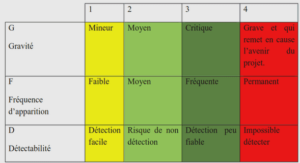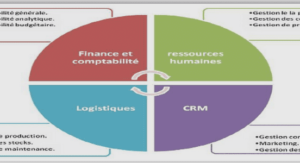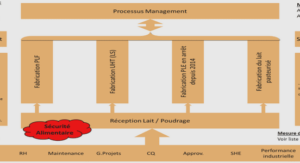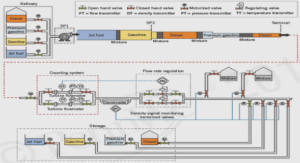PROJECT CONTROL
Project management is the discipline of planning, controlling and managing resources to bring the success of completion of specifie project goal or aim. One of the fundamental responsibilities of a project manager is to make sure that aIl kinds of administration behaviours are done as they are supposed to be done. In that case, it can bring the success of completion of specific project goal. In other words, this kind of responsibilities was called control. Control is the act of reducing the difference between plan and reality. It is also the last element in the implementation cycle of planning-monitoring- controlling. In essence, control is the act of reducing the difference between plan and reality. 18 In the world of project management, the term « control » is much more analogous to drive a coach to take a trip. The driver must keep making course adjustments with the original destination as promised in the beginning of the voyage. The driver must make sure bring the customers to the correct destination safely on time as promised in the beginning of the voyage. And the successful project voyage must include carefully charting a course to destination, driving to destination on time, distinguishing location on the map, paying attention to weather, and keeping a watchful eye on speed and so forth. Project control, of course, is one of the most important areas in project management. First, it involves bringing actual performance into the congruence with the original plan. Project control is one of the fundamental components in the world of project management. In every project, project control that is defined as the behavior of reducing the difference between plan and reality is the necessary pro cess which involves monitoring progress of the plan, analyzing the variances including cost, time and so forth, taking necessary corrective actions, ev en stop the project when it is necessary to accomplish the project according to given target. This kind of behavior is the fundament guarantee that can push the whole project forward to given destination.
Furthermore, project control can be used as an effective project method to make project move on the right track. Specifically speaking, good project control can significantly improve project performance and reflect the project situation precisely. It can provide more information for the administration level. Specifically speaking, it can make the project on the original routine and keep costs competitive and maintain schedule integrity. For example, effective project control not only can reduce the fixed costs, but also deal with the variable cost highly competently. While, in today’s modem project management, except traditional cost and schedule control, scope control, risk control, quality control, and customer satisfaction control emerges. They are becoming the new focus for project managers. Generally speaking, good project control usually can be used as a strategic tool to enhanced competitive forces in the market. Project control is not the only factor that can guarantee project success, but it is one of the most important factors. Generally, the regulation of results through the alteration of activities and the stewardship of organizational assets are two fundamental pUl »poses of control. The final objective of project control is to reduce the difference between plan and reality. While, controlling the destiny of certain project is not simple for project managers. Maintaining control in terms of minimizing the distance between plan and reality is always the subject of controlling. That means project managers should keep an eye on the future, the y must know clearly aIl kinds of variances and deal with these variances under a reasonable range.
PERFORMANCE ANALYSIS AND DECISION MAKlNG
Project performance is the behaviour of project control. And project performance is also called project efficiency which is measured by the Eamed Value Management (EVM) indicators, cost and schedule performance indexes, CPI and SPI, respectively. 19 Furthermore, it is also measure by Eamed Schedule Indexes, like SPI (c um) and so on. Actually, project performance is measured by a set of indexes, like CPI, SPI, TCPI, and TSPI and so forth, which provide infom1ation conceming project progress. For a simple example, if the SPI is less than 1.0, which means the project is performing less than the planned performance as to the reporting time, project managers will put more labour resources on it to catch the schedule. EVM is still the best effective project management tool to monitor the health of project for project managers so far. Even project managers hold this tool, but this kind of tool does not provide the corrective action tips. Furthermore, whatever project managers who do something wrong or right will buy time. If they do the corrective actions, and will get the project back on course, otherwise, project performance will go worse.
All these situations are due to lack of relationship between the project performance and corrective actions. We cite part of the model that Walt Lipke developed in 2003.20 Lipke indicated that expect the project performance, there are other considerations needed to make the management decision, which are sufficiency of data, possible strategy and sufficient time. He also pointed that there are four basic actions inside this model, the y are as follows:
• No Action Required
• Investigate
• AdjustlRealign
• Negotiate
Lipke also gave the explanation of these four actions, obviously, it is easy to understand the first two items, when the project is performing weIl, and the project managers would be wise to not make any changes. While, if the project has poor performance, but has insufficient data, the project managers would investigate for potential causes and data definitely. The AdjustiRealign and Negotiate actions are not so simply connected to the analysis results. The project manager should negotiate additional co st and/or schedule, ore reduction of requirements, only when a recovery strategy is not possible, or there is insufficient time for the recovery to be effective. 14 The figure 8 shows the relationship between project performance and actions as follow; 20 Walt Lipke, Deciding to Act, Cross Talk, The Journal of Defense Software Engineering, Dec., 2003 Issue.
THE PROPOSED METHODOLOGY
Earned Value Method has been set up to deal with the complex task of controlling and adjusting the baseline project schedule during execution, taking into account project scope, timed delivery, total project budget. It is a well-known and generally accepted method that integrates cost, schedule and technical performance. There are always three parameters present in EVM: Planned Value, Actual Cost and Eamed Value. With these three parameters a series of indexes and ratios can be obtained (show CV, CPI, EAC, ETC, SV, SPI). Although the classic earned value metrics are designed to forecast both time and cost, these metrics are purely cost-based. In fact, it has been documented that CV, CPI, ETC, EAC (all these are indexes from the co st si de of the project) are very accurate but there is a problem with the schedule side (SV and SPI) . Recently, this problem has been tackled by researchers (Lipke, 2003 and Vandevoorde & Vanhoucke, 2006) and it leads to the Earned Schedule method (ESM). This technique has shown very interesting results, and can be considered as a new alternative for the more classic earned value metrics for the evaluation of the schedule performance of the projects. So, EVM indicators and ESM indicators can be considered as accurate to evaluate the cost and schedule performance of the project. For Assessing and Controlling the Quality of a Project End Product, a Quality Earned Method has been developed (Paquin, Couillard & Ferrand, 2000). These methods (EVM, ESM and EQM) provide early indications of project performance to highlight the need for eventual corrective actions. But, there is still another step, the choice of a good corrective or recovery action. To the best of our knowledge, no research has been done to tackle directly this aspect prior to this paper, may be excepted the the paper of Lipke (2003b) which proposes a decision logic coupling the decision data (perfonnance indicators, sufficiency of data, of time) to the management of actions. However, the decision logic diagram doesn’t propose a ranking of the different possible strategies but classify them into one of the following categories:
ACKNOWLEDGEMENT |





